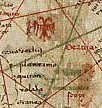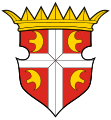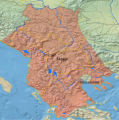Serbian Empire
The Serbian Empire (Serbian: Српско царство / Srpsko carstvo, pronounced [sr̩̂pskoː tsâːrstʋo]) was a medieval Serbian state that emerged from the Kingdom of Serbia. It was established in 1346 by Dušan the Mighty, who significantly expanded the state.
Serbian Empire
- Serbian (official)
- Greek
- Albanian
- Bulgarian
- Common Romanian
16 April 1346
31 May 1349
1369
4 December 1371
250,000 km2 (97,000 sq mi)
During Dušan's rule, Serbia was the most powerful state in Southeast Europe and one of the most powerful European states.[2] It was an Eastern Orthodox multi-ethnic and multi-lingual empire that stretched from the Danube in the north to the Gulf of Corinth in the south, with its capital in Skopje.[3] He also promoted the Serbian Archbishopric to the Serbian Patriarchate. His son and successor, Uroš the Weak, lost most of the territory conquered by Dušan, hence his epithet.
The Serbian Empire effectively ended with the death of Uroš V in 1371 and the break-up of the Serbian state. Some successors of Stefan V claimed the title of Emperor in parts of Serbia until 1402, but the territory in Greece was never recovered.[4][5][6]
Culture
Religion
Influenced by the clergy, Dušan showed extreme severity towards Roman Catholicism. Those who integrated into the Latin Church were condemned to work in mines, and people who propagated it were threatened with death. The Papacy grew concerned about this and the increasing power of Dušan and aroused the old rivalry of the Catholic Hungarians against the Orthodox Serbs. Once again Dušan overcame his enemies from whom he seized Bosnia and Herzegovina, which marked the height of the Serbian Empire in Middle Ages. However, the most serious menace came from the East, from the Turks. Entrenched on the shores of the Dardanelles, the Turks were the common enemies of Christendom. It was against them that the question of uniting and directing all forces in the Balkans to save Europe from the invasion arose. The Serbian Empire already included most of the region, and to transform the peninsula into a cohesive whole under a rule of a single master required seizure of Constantinople to add to Serbia what remained of the Byzantine Empire. Dušan intended to make himself emperor and defender of Christianity against the Islamic wave.[35]
Education and arts
Education, to which St. Sava had given the first impulse, progressed remarkably during Dušan's reign. Schools and monasteries secured royal favor. True seats of culture, they became institutions in perpetuating Serbian national traditions. The fine arts, influenced by Italians, were not neglected. Architectural monuments, frescoes and mosaics testify the artistic level archived during this period.[36][37]
For a list of magnates, feudal lords and officials, see Nobility of the Serbian Empire.









